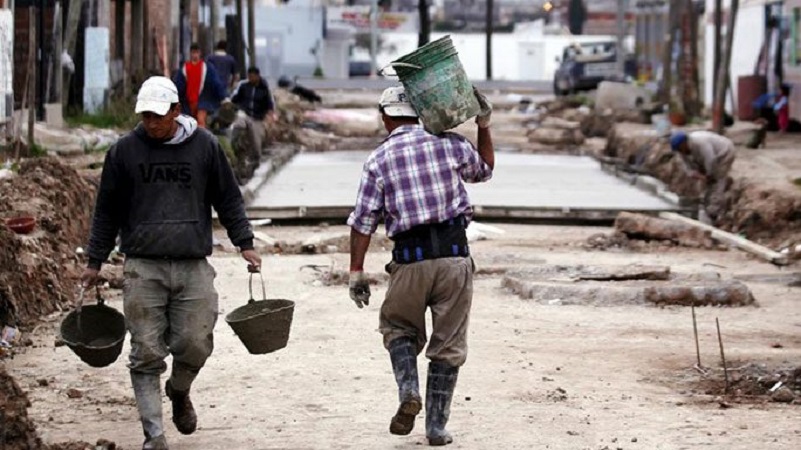
The working class is the main one affected by years of stagnant economy. The economic situation worsened with a new currency run and escalating prices. The Minister of Economy, Sergio Massa, implores the IMF for an advance on disbursements to strengthen the reserves that have fled from the Central Bank.
Before this escalation, the social situation was already very serious, 39.2% of the population is below the poverty line, 18 million poor throughout the country. That’s the photo from the second half of last year. With the acceleration of inflation this year there will be more poor people, according to specialists, poverty will exceed 40%.
Labor precariousness reigns
The last INDEC measurement for the fourth quarter of 2022, for the 31 urban agglomerates surveyed, shows 6.3% unemployment. The figure is much higher among youth (14 to 29 year old men, 12.6%) and among women (14 to 29 year old women, 13.6%).
If this percentage is extrapolated to the entire country, it turns out that there are around 1.4 million unemployed in Argentina.
While a sector of the population is unemployed, underemployed, those who manage to cover the minimum consumption are subjected to endless working hours. According to data from INDEC, the overemployed populationthat is, the one who works more than 45 hours a week, exceeds a quarter of the total employed: in 2022, the average was 28% when in 2021 it was 27%.
In recent years there has been an increase in jobs and unemployment has fallen, but worse quality employment was created with low wages. According to data from INDEC’s Income Generation Account, jobs increased by 5% (+1.1 million) in the fourth quarter of 2022 compared to the same period in 2019. Of the total number of new jobs, what increased the most is unregistered employment (+477,415), that is, the most dynamic was precarious employment. Meanwhile, the positions of registered workers increased 379,131 and of the non-salaried (self-employed) 219,002 in the same period.
Unregistered worker positions in the fourth quarter of 2022 reached 5.6 million. The sector with the largest number of unregistered workers is work in private homes, reaching 1.2 million, most of whom are women. Of the total unregistered jobs it represents 21%. If the Permanent Household Survey is considered, in the fourth quarter of 2022 of the total wage earners the 35.5% do not have retirement discountsthat is, it is informal work.
growth for few
After the fall due to the pandemic in 2020, the Argentine economy recovered in 2021 and 2022, although it did not change the deeper trends towards the stagnation of the Gross Domestic Product (GDP) that had occurred a decade ago. However, this recovery It was not to improve the living conditions of the popular majorities as the Frente de Todos promised in the electoral campaign, but rather it went into the pockets and bank accounts of large companies. The pre-existing inequality between wage earners and businessmen deepened.
According to data from INDEC, the Gross Operating Surplus, a kind of approximation to the mass of business profits, went up their participation in the wealth generated in the country from 40.2% in 2016 to 44.6% in 2022. The counterpart is the decline in the Remuneration of Salaried Work that decreased its participation in wealth from 51.8% in 2016 to 44.9% in 2022. This generated wealth is a product of nature and human work. But the capitalist class bases its profit on the non-payment of part of the work done by the working class. Through this mechanism you can appropriate and increase your wealth.
The decline in living conditions is expressed in the collapse of purchasing power: in it registered private sector reaches 21.6% (February 2023 versus October 2015); in it public sector 28.8% (February 2023 versus October 2015) and among informal a higher value of 37.8% (but the drop is observed in a shorter period, February 2023 versus October 2016, which is when the official statistics begin). Alberto Fernández did not fulfill the promise to reverse the salary loss operated during the Government of Mauricio Macri. On the contrary, the fall continued, although in a less accentuated way.
The deterioration of purchasing power for several years (five years of consecutive decline) caused there to be working poorIn other words, even if they have a full-time job, their salary does not allow them to even reach the poverty basket prepared by INDEC (a basket that does not include the cost of rent).
A CTA Cifra report noted that in the third quarter when 37.9% of the population had incomes below the poverty line, 28.7% of employed people were poor despite having earned income. The situation is more serious for unregistered workers, about 45% of informal workers were in a situation of poverty.
For his part, retirement and social programs they also lag behind inflation. He have minimum in the first quarter of the year it was 16% below the average level of 2019, and the Universal Child Allowance it lost 26.2% of purchasing power in the same period, according to Cifra.
Again wage and price agreement
Moonlighting, precarious employment, poor workers are features of the current labor market. The data shows a situation of strong social deterioration and the crisis will exacerbate it. In this context, and a few days before May 1, International Workers’ Day, the economy minister called for a price and wage agreement for the next 90 days. A social agreement with the representatives of workers and employers with the aim of aligning prices and wages. The union leaders, instead of being at the forefront of a plan of struggle to recover all that was lost, sat down at the table with Massa to negotiate this pact.
The Government intends to control the “price makers” when it has already been shown that this policy failed, it is the large companies that have raised prices in recent weeks, failing to comply with the agreements in the face of the currency run.
On the other hand, these agreements have already been attempted at other times in national history and have always come to nothing, as happened with the Social Pact of Perón and his Minister of Economy Gelbard in 1973, which broke out due to the rise of workers, the economic and political crisis. . Employers want greater freedom to mark prices, stop as much as they can the equal claim of workerswidening the gap between the price of the goods they sell and the wages they pay, which it allows them to increase their profits at the expense of the working class.
The mobilizations of the teachers, the cutoff of the Panamericana by the Mondelez workers in rejection of job insecurity, the strikes of the subway workers due to the reduction of the working day, show that the working class no longer wants to continue losing and it will face the bosses’ plans for greater attacks. Given this panorama, a national strike and a plan of struggle on the way to a general strike are urgently and necessary to defeat this new looting in progress along with other measures such as an emergency increase in wages, pensions and social programs, and the incorporation of clauses trigger that updates month by month according to inflation, reduction of the working day to 6 hours and 5 days a week and the distribution of working hours, among others.
This May 1st there are plenty of reasons to participate in the International Workers’ Day event organized by the Left Front. Against the bosses’ politicians and in support of the struggles that are taking place in the world, to put the working class on its feet and reorganize the country from below.
Source: www.laizquierdadiario.com

